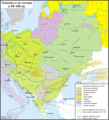Fil:Slav-7-8-obrez.png

Størrelse af denne forhåndsvisning: 544 × 599 pixels. Andre opløsninger: 218 × 240 pixels | 436 × 480 pixels | 698 × 768 pixels | 930 × 1.024 pixels | 1.860 × 2.048 pixels | 3.051 × 3.359 pixels.
Fuld opløsning (3.051 × 3.359 billedpunkter, filstørrelse: 339 KB, MIME-type: image/png)
Filhistorik
Klik på en dato/tid for at se filen som den så ud på det tidspunkt.
| Dato/tid | Miniaturebillede | Dimensioner | Bruger | Kommentar | |
|---|---|---|---|---|---|
| nuværende | 12. aug. 2023, 17:13 |  | 3.051 × 3.359 (339 KB) | Gyalu22 | Reverted to version as of 13:16, 23 October 2022 (UTC) Look at the atlas, don't do your own research |
| 1. jun. 2023, 19:43 |  | 3.051 × 3.359 (309 KB) | Shibbolet3579 | enice was still in the Byzantine Empire at this time. Avars were also present around Vienna and in central Transylvania, evidenced by graves & toponyms. There was a linguistic contact between Albanians and Vlachs, evidenced by the non-Slavic words present in both languages. Placed the Etelköz of the Magyars and the Crimean byzantine Greeks. South-Slavic toponyms (as Trnava for "tip, hillock, mound") evidenced a South-Slavic presence in southern Transylvania. Concerning the Eastern romance spe... | |
| 23. okt. 2022, 15:16 |  | 3.051 × 3.359 (339 KB) | Gyalu22 | Reverted bad faith edit, restored to version as of 26 July 2011. The Westermanns Atlas is an irrelevant source for the previous map, as only the Southern Carpathians are shown as possibly inhabited by the Wallachians. | |
| 28. apr. 2014, 17:09 |  | 3.051 × 3.359 (302 KB) | Spiridon Ion Cepleanu | Bulgarian kingdom & east-romance vlachs according with the universitary atlases of history and the Grosser Atlas zur Weltgeschichte, dir. Hans-Erich Stier, Westermann, 1985, ISBN 3-14-10-0919-8, pp. 50, 55-57, 61 & 64. | |
| 26. jul. 2011, 20:27 |  | 3.051 × 3.359 (339 KB) | Koryakov Yuri | The map's resolution is drastically decreased. Undo | |
| 26. jul. 2011, 06:53 |  | 544 × 599 (329 KB) | Spiridon Ion Cepleanu | On the original version of this map, the eastern romance language-spoken populations ("Vlachs" or "Volokhs") are draw only in a little area around Sredets (today Sofia), according with only one of the POVs, called "Röslerian" (since Eduard Robert Rösler | |
| 10. mar. 2008, 15:52 |  | 3.051 × 3.359 (339 KB) | Koryakov Yuri | {{Information |Description= |Source= self-made |Date=March 2008 |Author= Koryakov Yuri |other_versions= }} == Licensing == {{self|cc-by-sa-3.0}} Category:Maps of the history of Russia in Russian [[Category:Maps |
Filanvendelse
Den følgende side bruger denne fil:
Global filanvendelse
Følgende andre wikier anvender denne fil:
- Anvendelser på ar.wikipedia.org
- Anvendelser på arz.wikipedia.org
- Anvendelser på azb.wikipedia.org
- Anvendelser på ba.wikipedia.org
- Anvendelser på be-tarask.wikipedia.org
- Anvendelser på be.wikipedia.org
- Anvendelser på bg.wikipedia.org
- Anvendelser på ce.wikipedia.org
- Anvendelser på cs.wikipedia.org
- Anvendelser på cv.wikipedia.org
- Anvendelser på de.wikipedia.org
- Anvendelser på en.wikipedia.org
Vis flere globale anvendelser af denne fil.

